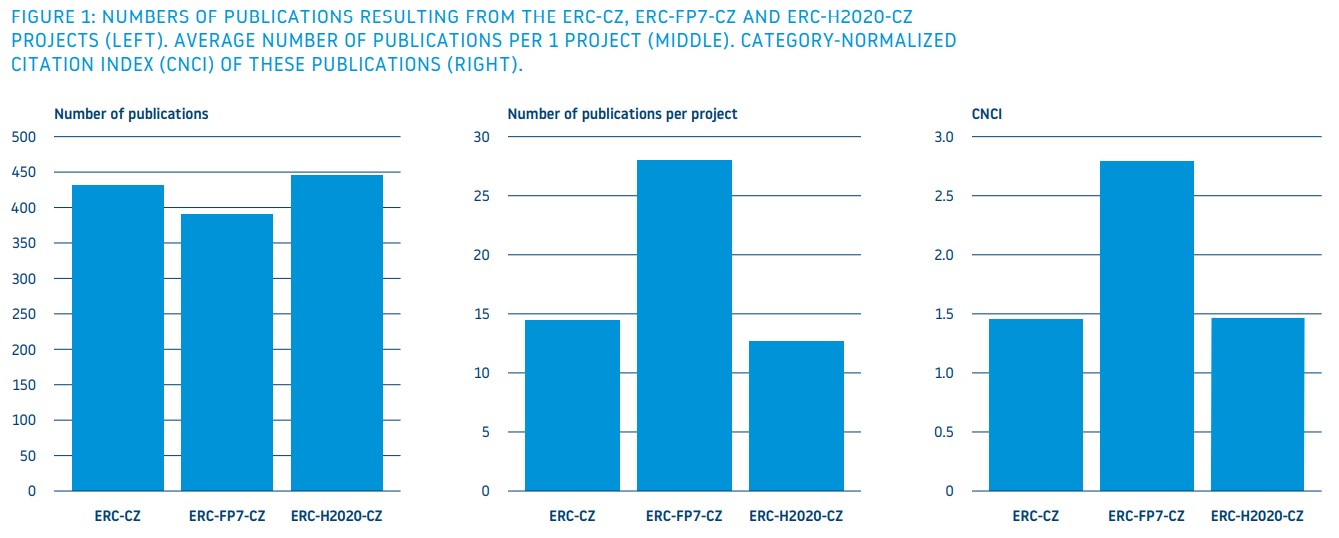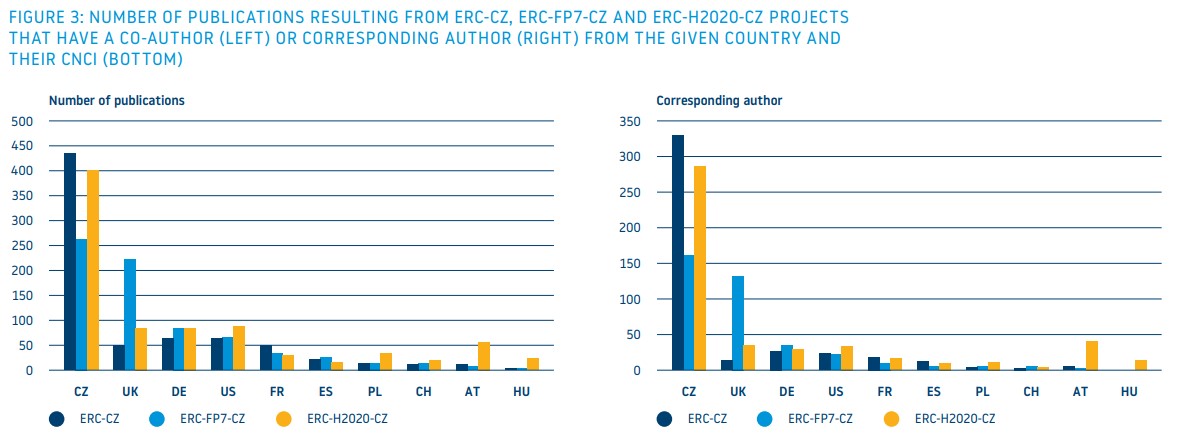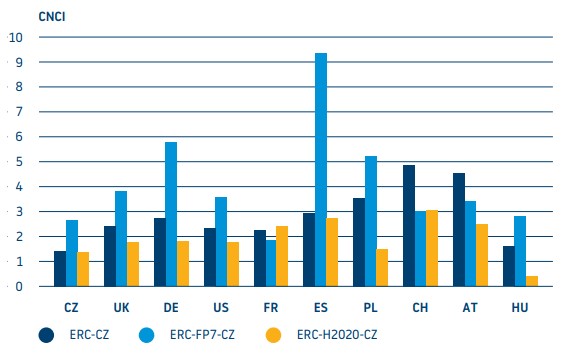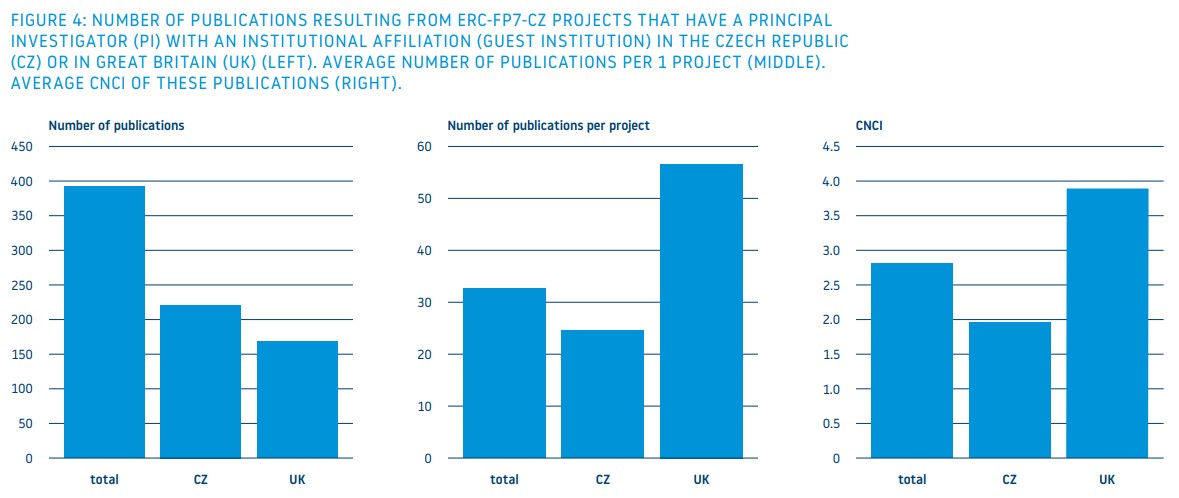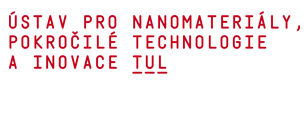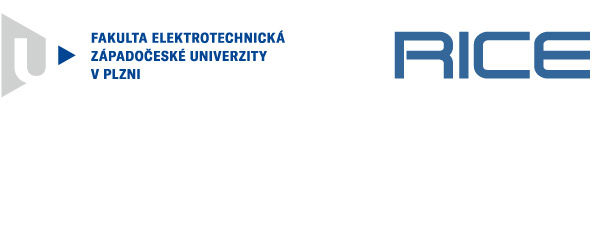Abstract
The ERC – CZ programme was established in 2010 with the aim of supporting excellent research in the Czech Republic by implementing project proposals that were submitted to one of the calls of the European Research Council (ERC) and were evaluated by international expert panels of the European Research Council but did not receive support from European funds – or respectively, from FP7 and the H2020 programme.
Between 2012 and 2021, a total of 30 projects were supported from the ERC-CZ programme. In this analysis, we compared the publication results of this programme with the publication results of the ERC-FP7 and ERC-H2020 projects involving Czech research institutions (so-called ERC-FP7-CZ and ERC-H2020-CZ projects) either as the host institution of the main investigator of the project, or as a partner institution, providing the main investigator with partial services and activities necessary for solving the project.
Our analysis shows that ERC-CZ is a relatively successful programme, as it produces on average a slightly higher number of publications per project than the number yielded by ERC projects with the participation of Czech institutions in the H2020 programme. The bibliometric quality of publications from ERC-CZ also is comparable to that of publications from the ERC-H2020-CZ projects. Although ERC-CZ publications have a slightly lower level of international cooperation than ERC-H2020-CZ publications, their normalized citation rate (CNCI) is the same. Publications from ERC-FP7-CZ have an even higher citation rate, but this is most likely due to the fact that almost half of these publications came from projects that had a main host institution in the UK and were led by experienced principal investigators (PI) affiliated with British institutions.
Introduction
European Research Council (ERC) grants have been awarded ever since the start of FP7 in 2007. Grants are awarded “to address breakthrough research” that leads to significant results and has the potential to push forward the boundaries of human knowledge. Project proposals to highly competitive contests (calls) can be submitted by scientists/researchers from all over the world who wish to address an ERC project in a given institution of an EU Member State or a country associated to the Framework Programme. ERC supports both fundamental and applied research, does not set priorities or thematic limitations; calls are open to all scientific areas (so-called bottom-up approach). The bottom-up approach has remained a key feature since 2007, when ERC grants were introduced into FP7 under the Ideas priority. Even in the H2020 programme, this approach has not changed. ERC is part of Pillar 1 Excellent Science. The only criteria that are evaluated in case of ERC grants are the quality of the project proposal (scientific excellence) and the person of the principal investigator. The evaluation process is multi-round, based on the evaluation of scientific panels composed of recognized scientists picked by the ERC Scientific Council, who rely on the opinions of independent experts to discuss the submitted project proposals” (Čapková 2021).
In the long term, applicants from the Czech Republic have not been very successful in obtaining the ERC grants. In response to this development, a program funded by the Government of the Czech Republic called ERC-CZ was created. The ERC-CZ programme is aimed at supporting excellent projects of researchers who applied for a Grant from the European Research Council and were evaluated as excellent, but failed to receive an ERC grant from the FP7 or H2020 programme (MEYS 2018).
The ERC-CZ programme was approved by the Government of the Czech Republic on 7 December 2010 for the period 2012–2019 with an allocation of CZK 600 million. Government Resolution no. 190 of 9 March 2016 approved the extension of the programme until 2021. The Ministry of Education, Youth and Sports (MEYS 2018) is the provider. The ERC-CZ programme is announced in the form of repeated public tenders following the publication of the results of project evaluations from the European ERC calls.
The aim of the ERC-CZ programme is to support excellent research in the Czech Republic by implementing project proposals submitted to one of the calls of the European Research Council, which were included in the international peer review evaluation carried out by ERC expert panels, but did not receive support from European funds” (MEYS 2018). Between 2012 and 2021, a total of 30 projects were supported by the ERC CZ programme (MEYS 2021, CEP 2022) with a total budget of about CZK 550 million (almost €22 million).
In our analysis, we wanted to compare the publication outputs of the ERC-CZ projects with the results of ERC projects funded under the FP7 and H2020 programmes, in the solution of which the Czech research institution participates either as a host or as a partner institution (see below) – the so-called ERC-FP7-CZ and ERC-H2020-CZ projects.
Methods
The publications produced during the period 2007 to 2020 from the ERC projects of the FP7 and H2020 programmes, in which Czech institutions participated (in this study we refer to them as ERC-FP7-CZ and ERC-H2020-CZ projects), were downloaded from the eCorda database in February 2022. Publications created during the period 2007 to 2020 from all projects of the ERC-CZ programme were withdrawn from the RIV IS RDI (Index of Information on the Results of the Research, Development and Innovation Information System) in February 2022 (RIV 2022). All publications where DOI was identified were then downloaded from the WoS database (WoS 2022) and exported to InCites during April 2022. (Note: Consequently, our bibliometric analysis does not include all publications that arose from the solutions of the ERC-CZ, ERC-FP7-CZ and ERC-H2020-CZ projects, but is limited only to those that had the DOI and were traceable in WoS.)
For all sets of publications, we analysed the following parameters: the number of publications, their citation rate normalized by field and type of publication (CNCI), the share of publications published in Q1 journals, the share of publications created within the framework of international cooperation and the share of publications whose first or corresponding author has an affiliation in a Czech institution.
Results and discussion
Number of publications
The total number of publications from all ERC-CZ projects listed in the RIV was 549, of which 462 publications indicated their DOIs. The total number of publications listed in the eCorda database from all ERC-H2020 projects with the participation of Czech institutions (ERCH2020-CZ) was 690 (of which 617 had DOIs) and from ERC-FP7-CZ projects the number of publications was 604 (of which 434 publications had DOIs). WoS and InCites index 432 publications from the ERCCZ programme, 445 publications from the ERC-H2020-CZ projects and 392 publications from the ERC-FP7-CZ projects (Fig. 1 top). After conversion to the number of projects, ERC-FP7-CZ produced an average of 28 publications per project (Fig. 1 in the middle). In ERC-CZ almost half less publications were created per project and in ERC-H2020-CZ even 55% less.
Citation rates stadardised by field and type of publication (CNCI)
Publications resulting from the ERC-FP7-CZ projects had the highest citation rate, their average CNCI is about 2.8 (Fig. 1 bottom). Publications from the ERC-CZ and ERC-H2020-CZ projects had a significantly lower citation rate, although still significantly above average (CNCI is about 1.46 for both programmes).
Share of publications published in Q1 journals and intensity of international cooperation
The highest share of publications published in journals belonging to the highest quartile (Q1) was held by publications resulting from the ERC-FP7-CZ projects (almost 80%), a lower share was in publications from the ERC-CZ and ERC-H2020-CZ projects (about 60%) (Fig. 2 at top).
A higher share of publications with an international team of authors was created in the ERC-FP7-CZ and ERC-H2020-CZ projects (almost 70%), a slightly lower share of international publications was created in the ERC-CZ projects (about 60%).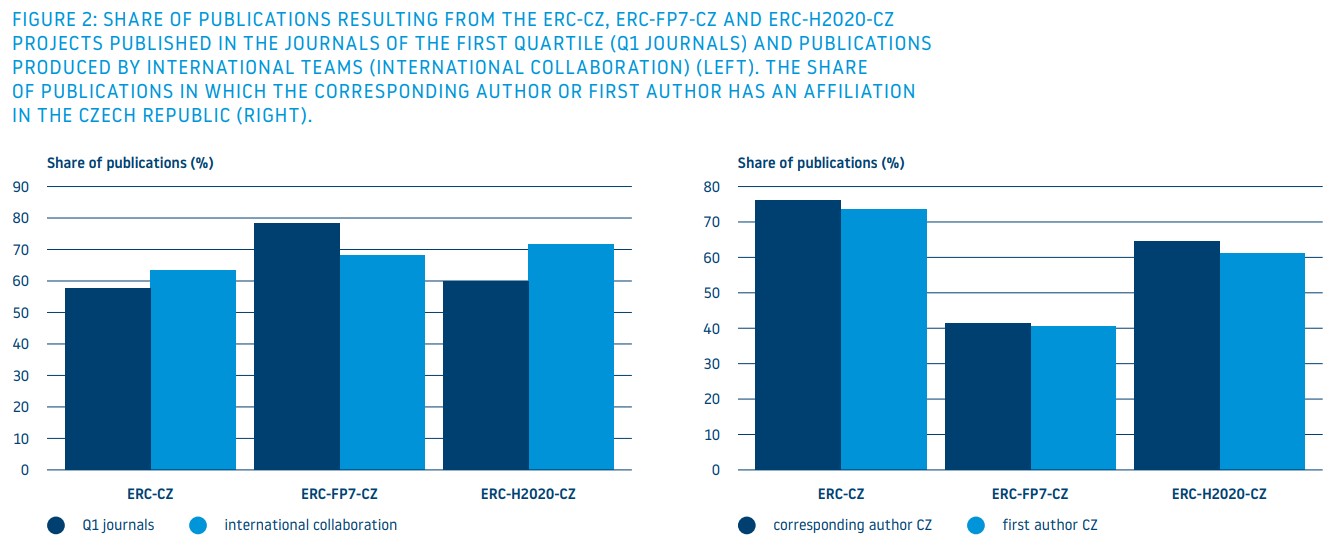
Share of publication of which the first or correspodning author ha an affiliation to a czech institution
We also analysed the proportions of publications in which a researcher affiliated in a Czech institution was listed as the first author or as the corresponding author (see Fig. 2 lower part). The author mentioned as the first author is usually the one who has the greatest share in con- ducting research, has the greatest merit in obtaining documents and information for the publication and also plays an important role in its writing. For publications from the ERC-CZ and ERC-H2020-CZ projects, the first author has an affiliation in the Czech Republic in 73% and 61% of publications, respectively. However, for ERC-FP7-CZ projects, this applies to only about 40% of publications.
The corresponding author is usually the ideological leader of the team, responsible for the entire concept of the research project, who also plays a decisive role in the writing of the publication. For publications from the ERC-CZ and ERC-H2020-CZ projects, the corresponding author has an affiliation in the Czech Republic in ca. 76 % and ca. 64 % of publications, respectively. However, for publications from ERC-FP7- CZ projects, a Czech corresponding author is mentioned only in about 41% of cases. However, a high proportion of publications (34 %) from ERC-FP7-CZ projects had a corresponding author from Great Britain (data not shown in Fig. 2).
Who do Czech authors collaborate with in the ERC-CZ, ERC-FP7-CZ and ERC-H2020-CZ projects and how this affects citation of the resulting publications
For the ERC-CZ and ERC-H2020-CZ projects, the vast majority of publications have at least one co-author from the Czech Republic and more than 60% of publications also have a corresponding author affiliated in a Czech institution (Fig. 3 top and middle). However, the situation is different for ERC-FP7-CZ projects, where only about 66% of publications have at least one author affiliated in a Czech institution and only 41% of publications have a corresponding author affiliated in a Czech institution. This is not high enough by far, considering that all publications are the results of projects involving Czech institutions. On the other hand, a large number of publications from ERC-FP7-CZ have at least one co-author affiliated in the UK (56% of publications) and many of them also have a British corresponding author (34% of publications). This means that in more than a third of these publications, British scientists played a major role.
It must be said that publications from all ERC projects (i.e. ERCCZ, ERC-FP7-CZ and ERC-H2020-CZ), on which foreign co-authors are listed, generally have a higher citation rate than the publications of Czech co-authors (Fig. 3 bottom). However, since the publications of foreign co-authors make up only a small share of the ERC-CZ and ERC-H2020-CZ projects, their influence on the overall citation rate is small. It is different, however, in the publication outputs of the ERCFP7-CZ grants, where the publications of British co-authors make up more than half of all publications.
Publications resulting from the ERC-FP7-CZ projects with British co-authors also had a 40% higher citation rate than publications with Czech co-authors. Publications by co-authors from other countries, especially Germany or Spain, also have higher CNCI, but there are far fewer of them than the British ones and therefore their influence on overall citation is limited. This suggests that the high average citation rate of publications from ERC-FP7-CZ may be due to the participation of foreign (and namely British) co-authors or corresponding authors.
Influence of the principal investigator (PI) affiliated in a British institution on the citation of publications created in the ERC-FP7-CZ projects
The eCorda database allows not only the identification of publications that have arisen from projects solved in various institutions, but also from projects of various PIs. All analysed publications were created within the framework of the ERC-FP7-CZ and ERC-H2020-CZ projects solved (or co-solved) in Czech institutions. However, a Czech institution can be either a host institution where the principal investigator carries out the main part of his research (which may be a Czech or a researcher of another nationality), or a partner institution that provides the principal investigator with additional services: partial research activities, expertise, partial data analyses are carried out there on equipment that the principal investigator does not have in the host institution, etc. These partner institutions employ researchers who participate in these activities and thus cooperate with the principal investigator and, of course, then also participate in the resulting publications as co-authors.
Within these grants, the principal investigator may be affiliated to a Czech or foreign institution. In the ERC-FP7-CZ projects analysed in this paper, publications with a valid DOI were produced in projects led by the principal investigators affiliated with either a Czech or a British research institution, only one publication arose from the project of the principal investigator affiliated in an Austrian institution. In order to verify the hypothesis that the high citation of publications from ERC-FP7-CZ may be due to the participation of British scientists in the role of the main authors, we have separately downloaded publications from the eCorda database from projects led by the principal investigators from the Czech Republic and from Great Britain and analysed them separately. In this analysis, we omitted one publication of the principal investigator affiliated in an Austrian institution.
It turned out that publications from projects led by the principal investigator affiliated with a British institution represent almost half (about 43%) of all publications and have an average citation rate almost 2 times higher than publications from projects led by the principal investigator affiliated with a Czech institution (Fig. 4 top and bottom). This confirms our hypothesis that the high average citation rate of publications resulting from the ERC-FP7-CZ projects is due to the participation of British researchers in the role of principal investigators - or main authors. What’s more, projects led by the British principal investigator also have a much higher productivity, as on average they produce 56 publications per project, while in projects led by the Czech principal investigator there are only 25 publications per project (Fig. 4 in the middle).
Conclusion
On the whole, our analysis shows that ERC-CZ is a relatively successful programme, as it produces on average a slightly higher number of publications per project than the number yielded by ERC projects with the participation of Czech institutions in the H2020 programme. The bibliometric quality of publications from ERC-CZ also is comparable to that of publications resulting from the ERC-H2020-CZ projects. Although ERC-CZ publications have a slightly lower intensity of international collaboration than ERC-H2020-CZ publications, their standardized citation rate (CNCI) is the same. Almost two times more publications per project are produced on average in ERC-FP7-CZ projects, and these publications also have a significantly higher citation rate, but this is due to the participation of experienced British principal investigators (PI) in almost half of these publications.
Autoři: Jiří Vaněček, Daniel Frank
Článek vyšel v anglickém vydání časopisu ECHO, který vydává Technologické centrum Praha.







